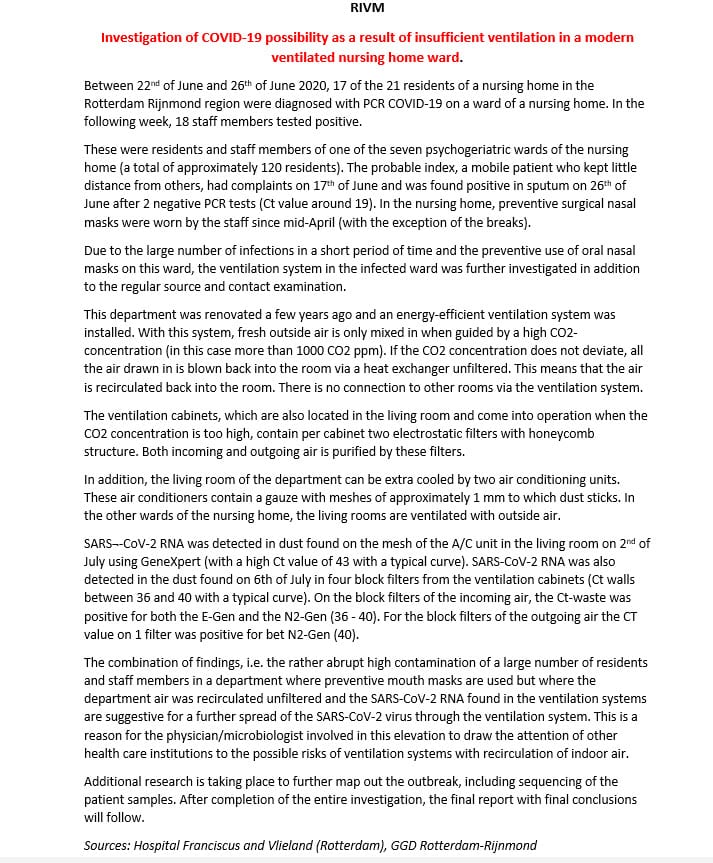A jaw-dropping report by the Dutch CDC provides strong evidence that poorly configured ventilation systems play their part in the massive spread of the virus among those who are present in those rooms (long-term). Clearly, aerosols play their part in the spread of the virus, but the Dutch CDC remains mysteriously sceptical.
Lees volledig artikel: Strong evidence effect ventilation on spread of Covid-19 in nursing home
Strong evidence effect ventilation on spread of Covid-19 in nursing home
I regularly receive relevant information from people working for official institutions, which is not disclosed to the public. Information which those persons believe to be important to share.
Its content reinforces the view that these official institutions only publish information that confirms their traditional views and justifies their choices. Information that contradicts this, must be ignored or – even worse – kept under wraps. Whatever the cost, be it public health, economic or social.
A few days ago I received such a piece. When I read it my jaw dropped. It took some time to really comprehend what it all meant. Not only the content of it, but also (and maybe especially) that the Dutch CDC (RIVM) did not share this information en masse.
(Translated from Dutch in English)
The findings
This is the summary of the document I received. It is an internal report to the Dutch CDC of a study commissioned by the local health organization of Rotterdam. You can read the translation of the whole document above.
- The date of this report is 23 July. While I am writing this it is 14 days later.
- This is a care institution with 7 separate departments and a total of 120 residents close to Rotterdam.
- At the end of June, 17 out of 21 residents tested positive in one of these wards. 6 of them died. Shortly afterwards 18 employees also tested positive.
- One knows which patient was the index patient.
- From mid-April the staff members wore professional mouth masks, except during their breaks.
- In view of these developments (the outbreak that took place almost simultaneously and that the staff wore mouth masks), the ventilation system was examined in addition to the normal source and contact examination.
- The description of the ventilation system shows that the department in question had been renovated not long ago. The ventilation system was not connected to the other departments. And the system was energy efficient, which meant that fresh air was only taken in (and heated or cooled) if the CO2 content was too high. Normally, therefore, the air was recirculated unfiltered.
Living room
In the living room of the ward there was also special ventilation equipment, plus 2 air conditioning units. This filter system was designed to remove dust from the air.
In the other wards this equipment was not available and the outside air was used directly for ventilation purposes.
- At the beginning of July, Covid-19 was found in several places in or near the filters of the ventilation system in this ward.
- In conclusion, the findings are “suggestive of the spread of the virus through the ventilation system”.
- It is also stated that the results prompted the involved microbiologists at the Rotterdam hospital, to draw the attention of other health care institutions to the possible risks of spreading the virus through recirculation of air through the ventilation system.
The conclusions
Once again: the wording of the investigation is by an employee of the Dutch CDC himself, who wrote this report. They used the terminology ‘suggestive of’ and ‘possible risks’. I seriously wonder what other possible explanation you could have for these research results, other than that the virus was spread through the ventilation system, so that even the staff members were infected when they did not have their mouthpieces on.
I assess these results as a hard confirmation of the many pieces of evidence:
- Poorly adjusted or just circulating ventilation systems play an important role in the massive spread of the virus among those who are (long-term) present in those rooms.
- Aerosols play a clear role in the spread of the virus. And that through those aerosols, many people can be infected at the same time in a relatively short period of time.
No fresh air
This also supports my thesis that since the beginning of April many people in care institutions have become ill (and died) due to the way the ventilation systems functioned. Little or no fresh air. And the spread of the virus over the entire department/through the entire building. Especially where many of the residents (and employees) have become infected, the chances are very high that it happened this way. In this way the viral doses are also extra high, so that a relatively large number of infected people die.
This is not only important information to evaluate what has happened in recent months, but even more importantly, it provides crucial information regarding the policy that now needs to be implemented to prevent new infections as much as possible from now on.
Because:
- Take aerosol contamination in confined spaces seriously.
- Make sure the ventilation systems are set properly and provide as much fresh air as possible.
You have just read: Strong evidence effect ventilation on spread of Covid-19 in nursing home.








